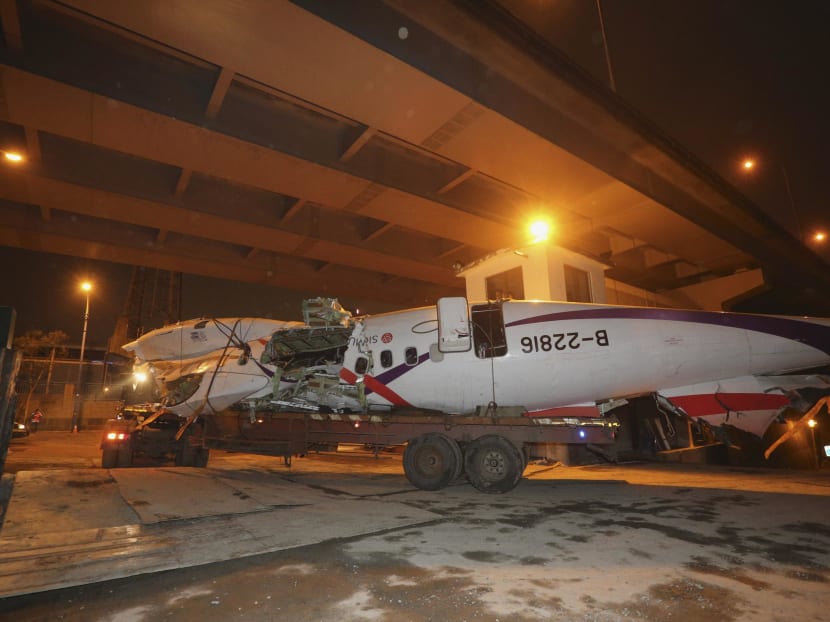Both TransAsia plane engines lost power before Taiwan crash
TAIPEI — One of the engines on TransAsia Airways Flight 235 went idle 37 seconds after takeoff, and the pilots may have shut off the remaining engine before attempting to restart them, but the plane crashed before that could happen, Taiwan's top aviation safety official said today (Feb 6).

Wreckage of TransAsia Airways plane Flight GE235 is transported on the back of a truck after it crash landed into a river, in New Taipei City, yesterday (Feb 5). Photo: Reuters
TAIPEI — One of the engines on TransAsia Airways Flight 235 went idle 37 seconds after takeoff, and the pilots may have shut off the remaining engine before attempting to restart them, but the plane crashed before that could happen, Taiwan's top aviation safety official said today (Feb 6).
The details were presented at a news conference in Taipei by Aviation Safety Council Executive Director Thomas Wang as preliminary findings from the flight data recorder.
Wednesday's crash into a river in Taipei minutes after takeoff killed at least 35 people and left eight missing. Fifteen people were rescued with injuries after the accident, which was captured in a dramatic dashboard camera video that showed the plane banking steeply and scraping a highway overpass before it hurtled into the Keelung River.
Mr Wang said the plane's right engine triggered an alarm 37 seconds after takeoff. However, he said the data showed it had not shut down, or "flamed out" as the pilot told the control tower, but rather moved into idle mode, with no change in the oil pressure.
Then, 46 seconds later, the left engine was shut down, apparently by one of the pilots, so that neither engine was producing any power. A restart was attempted, but the plane crashed just 72 seconds later.
Mr Wang said it was too early to draw firm conclusions about the reasons why the engines ceased producing power.
"It's only the third day so we can't say too much," Mr Wang said. "We haven't ruled anything out."
Taiwanese Vice President Wu Den-yih, mindful of the island's reputation as a tourist destination and its tense relations with China where most of the flight's passengers were from, went to a Taipei funeral parlor for prayer sessions to pay respects.
At the parlor, where bodies are being stored, Wu expressed condolences and praised pilot Liao Chien-chung, who died in the crash. The pilots may have deliberately steered the plane away from buildings and into the river in the final moments.
"When it came to when it was clear his life would end, (the pilot) meticulously grasped the flight operating system and in the final moments he still wanted to control the plane to avoid harming residents in the housing communities," Mr Wu said.
"To the plane's crew, the victims ... I here express condolences."
Divers with a local fire agency found one female and three male bodies today along the muddy Keelung River bottom about 50m from the crash site, a Taipei City Fire Department official surnamed Chen said.
The agency suspects the eight bodies that are still missing may be in equally murky areas and has sent 190 divers to look for them. Taiwan's Ministry of National Defense dispatched three S-70C rescue helicopters to search along a river system that runs into the ocean off Taiwan's northwest coast.
More than 30 relatives of victims cried wildly, prayed or were comforted by Buddhist volunteers at the riverside crash site as divers in black wet suits brought back the four bodies. Some divers came ashore with their hands joined in prayer for the people they brought back.
The pilot's and co-pilot's bodies were found earlier with their hands still on the controls, Taiwan's ETToday online news service said.
Mr Wang said the cockpit flight recorder was still being analyzed and a transcript would be provided as soon as possible.
Investigators are to issue a preliminary report on the crash within 30 days and a fuller report within 3-4 months. A final draft will be submitted within 8 months and the full investigation concluded in about a year, Mr Wang said.
He said the engines had shown no problems before the flight and repeatedly stated that the plane would have been able to take off and fly even with only one engine working.
Mr Earl Chapman of Canada's Transportation Safety Bureau told the news conference that the plane's Pratt & Whitney engines were known for their reliability.
"This engine type has millions of flight hours behind it with a very good safety record. So it's fairly unremarkable in that respect," said Mr Chapman, who was participating in the investigation because the engines were made by Pratt & Whitney's Canadian division. AP






